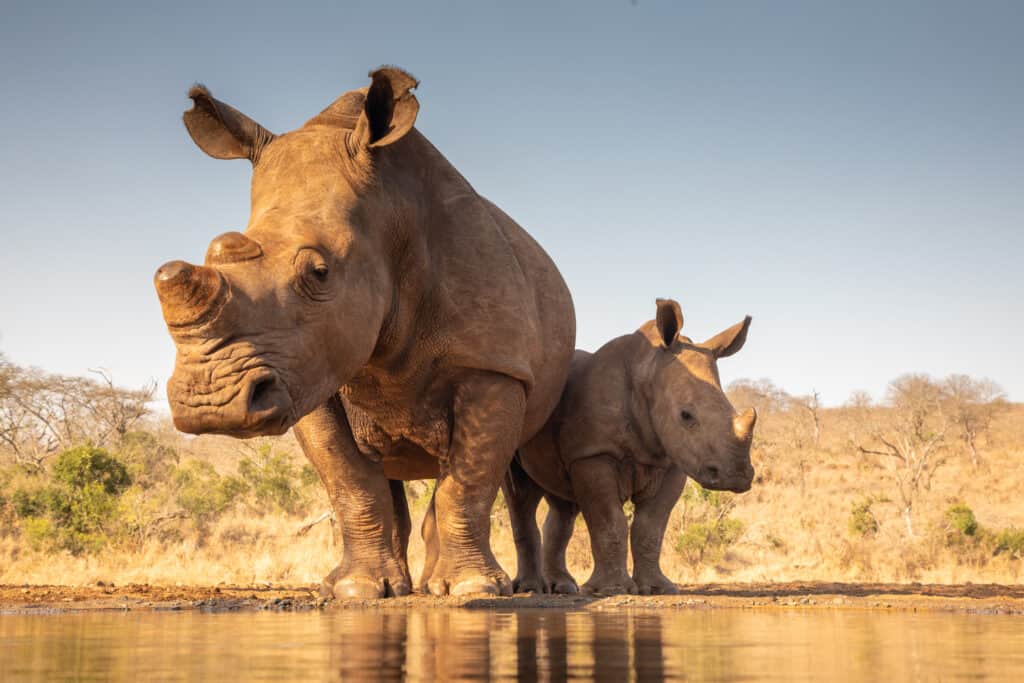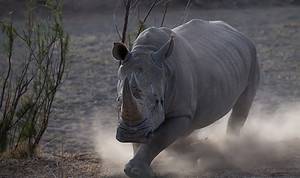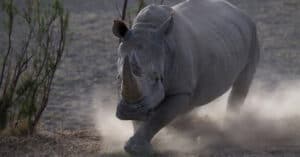Rhinoceros, or rhinos, have held our imagination for decades. These fascinating animals originate in Africa and Asia. While they once roamed in large numbers, poaching, and hunting have placed them on the endangered animals list. Rhinoceros have few natural predators outside of humans. Their thick skin, size and strength, and massive horns give them an advantage in the wild. Rhinoceros mothers are known to be very protective of their calves. Don’t miss this incredible footage of an angry rhino attacking a safari jeep that comes too close.
The Amazing Rhinoceros
There are two subspecies of rhinoceros: black and white. Rhinos stand up to five feet tall and can weigh between 2,000 and 4,000 pounds. Regardless of their subspecies, all rhinoceros are grey. Their differences aren’t in their hide color but in their size, horns, and anatomy. White rhinoceros, for example, tend to be larger with larger horns and square lips. Black rhinoceros are smaller and use their lips almost like fingers to pull and pluck foliage while foraging.
These large animals are vegetarians. Their primary food source is branches, twigs, and leaves. They’re vital to the ecosystem, as they spread plants through pollination. While they were once considered solitary, it’s now known that rhinoceros have social groups. White rhinoceros live in groups and have been documented gathering at watering holes. Female rhinos are also known to herd, especially while raising young.
They are Adapted to Survival
Rhinoceros exhibit a range of traits that assist them in defending against predators. Their hides can be up to five centimeters thick. They can also run up to thirty-four miles per hour. That’s faster than Usain Bolt, the current world record holder for speed.

The unique horns displayed by the rhinoceros have contributed to their endangered status.
©JONATHAN PLEDGER/Shutterstock.com
They use their massive horns in self-defense. Male rhinoceros fight for dominance and territory with their horns. Some rhinoceros have two horns, while others only have one. Sumatran rhinos have two horns, for example, while Javan rhinos have one. Rhinoceros horns grow back if removed, however, it can take up to three years to regrow.
The Five Types of Rhinoceros

It may look like a dinosaur, but it’s a Sumatran rhino, the only living rhino to be covered in hair.
©3owaldi/Shutterstock.com
There are five recognized types of rhinoceros. The White Rhino lives in Africa and is recognized as the second-largest land mammal next to the elephant. Black rhinos also live in Africa. The Greater One Horned rhinoceros is the largest land mammal to live in Asia, while the Sumatran rhino that lives in the Indonesian Islands is the only rhino covered in hair. Lastly, the Javan rhinoceros also lives in Indonesia.
The Rhinoceros Mother

If she feels her calf is in danger, an angry rhino mother will move to attack.
©iStock.com/PeterVanDam
A female rhinoceros will gestate, or carry a pregnancy, between fifteen and sixteen months. Following birth, she will nurse her calf for the next two years.
Baby rhinoceros are called calves. They’re born weighing about one hundred pounds and are able to stand and walk within hours. They stay close to their mothers for the first years of life. Once they’re mature, they will venture off on their own. Rhinoceros mothers are known to attack any perceived threat to their young, which you can see in the angry rhino in the video from Kruger National Park in Africa.
The photo featured at the top of this post is © Pornchanok Anukoolprasert/Shutterstock.com
Thank you for reading! Have some feedback for us? Contact the AZ Animals editorial team.






